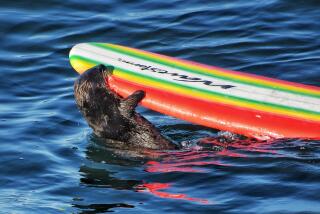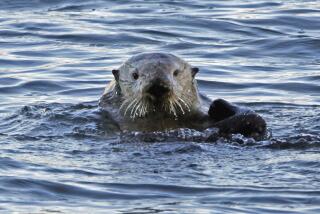Sea Turtles Adopting a New, Human-Populated Home
- Share via
GALVESTON, Texas — When two endangered sea turtles paddled from the surf to lay eggs here last year, preservationists were startled. Rarely did the feisty Kemp’s ridley turtles nest north of a sanctuary on Padre Island, about 250 miles away.
But history repeated itself this year, when another of the gray-green turtles swam to Galveston, burying 94 eggs the size of ping-pong balls in the sand between two beach houses.
“I about jumped out of my skin when I heard,” said Carole Allen, who directs the Gulf Coast office of the Sea Turtle Restoration Project. “They just popped up.... We weren’t expecting it.”
Like a surprise houseguest, the turtles received a mixed greeting in Galveston, south of Houston. Turtle lovers were elated but worried about protecting the vulnerable eggs. Others saw red tape as endangered turtles wandered on undeveloped waterfront property. Even biologists were of two minds, excited and puzzled by the turtles’ new nesting spot.
“We don’t know what’s bringing them in,” said Clark Fontaine, chief of the protected species branch at the National Marine Fisheries Service in Galveston.
For years, biologists believed that adult, egg-bearing Kemp’s ridley turtles returned by instinct to the beach where they were born, drawn by the memory of the sand. A federally funded turtle recovery program tested the theory by exposing newborn Kemp’s turtles to the Padre Island sand. The hatchlings were then sent to a lab in Galveston, where they lived in sea water for about a year before their release off the Padre Island coast.
More than a decade later, adult turtles returning to the upper Gulf Coast “may be responding to the chemicals in the water here,” Fontaine said. “It seems they’re coming home.”
The instinct that guided the turtles to Galveston unfortunately has led them to terrible nesting spots. In one case, the eggs were left on the last strip of beach open to vehicle traffic. Another pile of eggs got in the way of a plan to bring sand to eroding beaches. The state delayed the project so that eggs in undetected nests can hatch.
More complications are bound to follow if Galveston becomes a satellite nesting site, said Allen, the turtle activist. “People need to realize the turtles may be spreading out and could possibly be on the entire Texas coastline,” she said. “Compromises will have to be made.”
That may not be easy in a state better known for hunting wildlife than preserving it, she said. At a town meeting last fall, Allen chided residents who drove cars onto the beach. “I said ‘you’ve got endangered sea turtles here.’ They didn’t like that at all. I got a bunch of groans.”
Allen looked at the impatient faces and saw the future.
“It will get ugly,” she said. “It’s a big can of worms, one of those difficult issues with Texans.... People feel like it’s their God-given right to drive their trucks on the beach.”
Lorraine Brown, an open-beach advocate, said “a few crazies might not drive properly,” but most people are responsible. “We want protection for the wildlife and still be able to drive [on the beach].”
That the debate is happening at all is proof the turtles are making a comeback, Fontaine said.
“We’re getting more and more sea turtles,” he said. “All these conservation programs appear to be working.”
The major Kemp’s ridley nesting area is a beach near Rancho Nuevo, on the Gulf Coast of Mexico. In the mid-1940s, about 40,000 female turtles were filmed laying eggs there. The same film shows residents collecting the eggs to eat, or to export as supposed aphrodisiacs. In 1985, only 702 nests were found worldwide, said Donna Shaver, the station leader of the U.S. Geological Survey’s Padre Island field research station.
A joint Mexican-U.S. recovery program got underway in 1978 to help save the vanishing species, thought to be the world’s most endangered sea turtles.
Each year for 15 years, scientists collected 2,000 turtle eggs from Rancho Nuevo, carefully catching them in plastic bags as they emerged. None of the eggs was allowed to touch the sand.
The eggs were brought to Padre Island, where they hatched. As the tiny turtles padded over the beach, they theoretically filed away an “imprint” of the South Texas sand. Before they swam out to sea, the hatchlings were captured, then sent to the marine fisheries sea turtle facility in Galveston, the only one of its kind in the nation.
After a year in captivity, most of the turtles were returned to Padre Island, where they were released in the Gulf of Mexico. In 1996, the first confirmed tagged Kemp’s ridley returned to South Texas to nest. Since then, Padre Island has become a second stronghold for the turtles. In 2002, a record-breaking 38 nests were found along the Texas coast. The adult female population has grown to about 5,000, Shaver said.
The white, leathery eggs found in Galveston on May 16 are incubating on Padre Island. After the turtles hatch in the next month or so, they’ll be taken in Styrofoam containers to the edge of the beach and tipped onto the sand. Hundreds of people rise at dawn to watch the hatchlings scamper into the gulf.
“It’s a moving experience,” Shaver said. “Sometimes grown men have tears in their eyes. Here are baby turtles taking their first steps in life, going out into the world and facing very difficult odds.... But the nesting is spreading out, they’re establishing smaller base camps. They’re gaining momentum now.”
More to Read
Sign up for Essential California
The most important California stories and recommendations in your inbox every morning.
You may occasionally receive promotional content from the Los Angeles Times.













